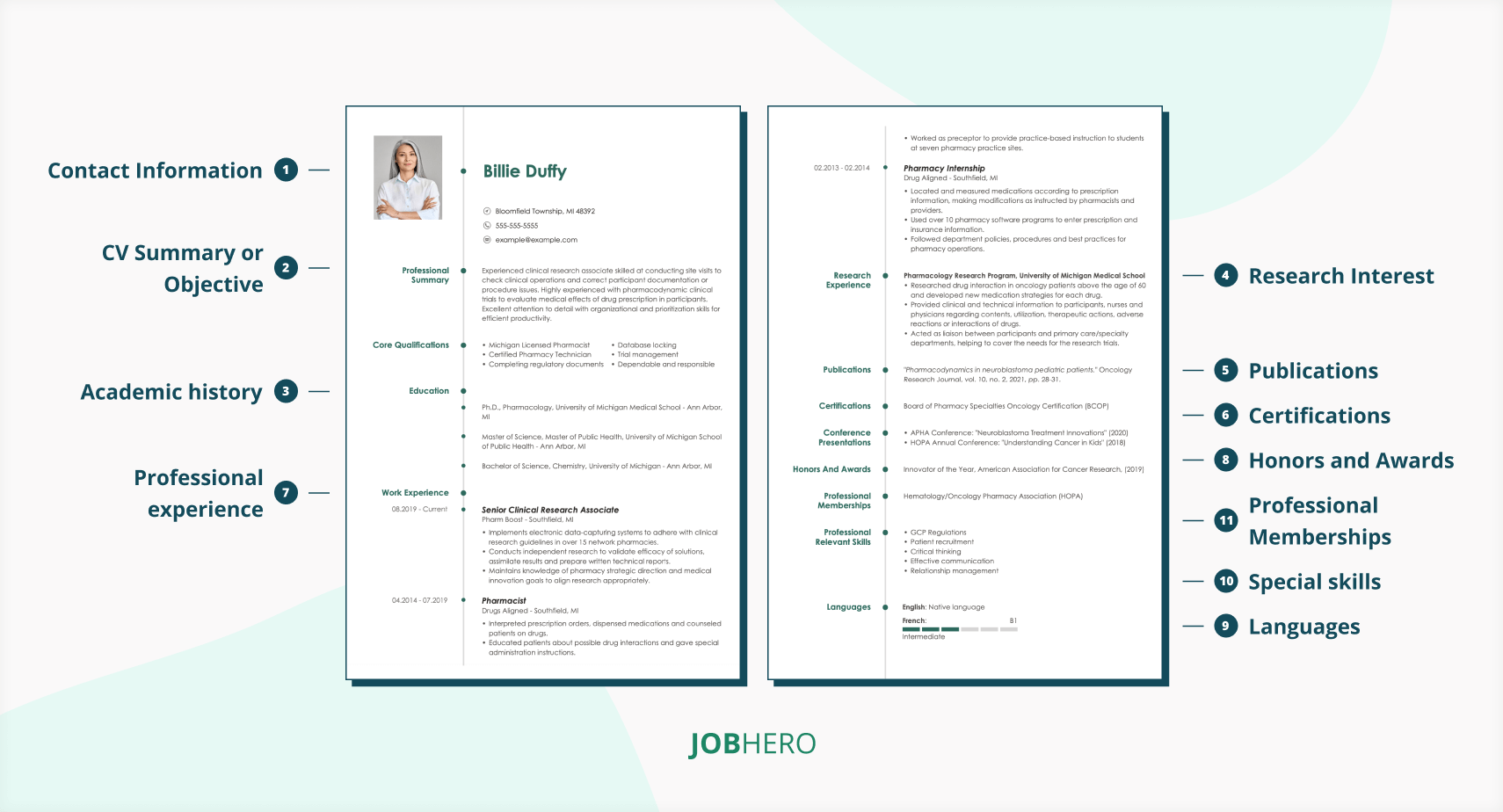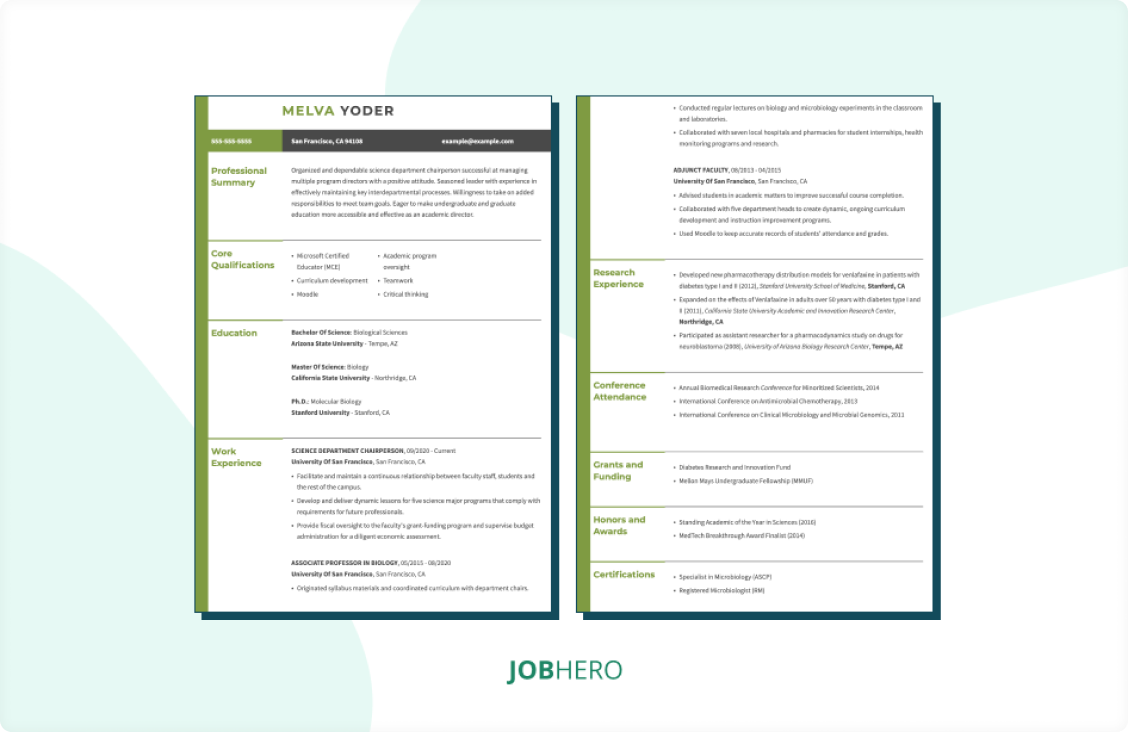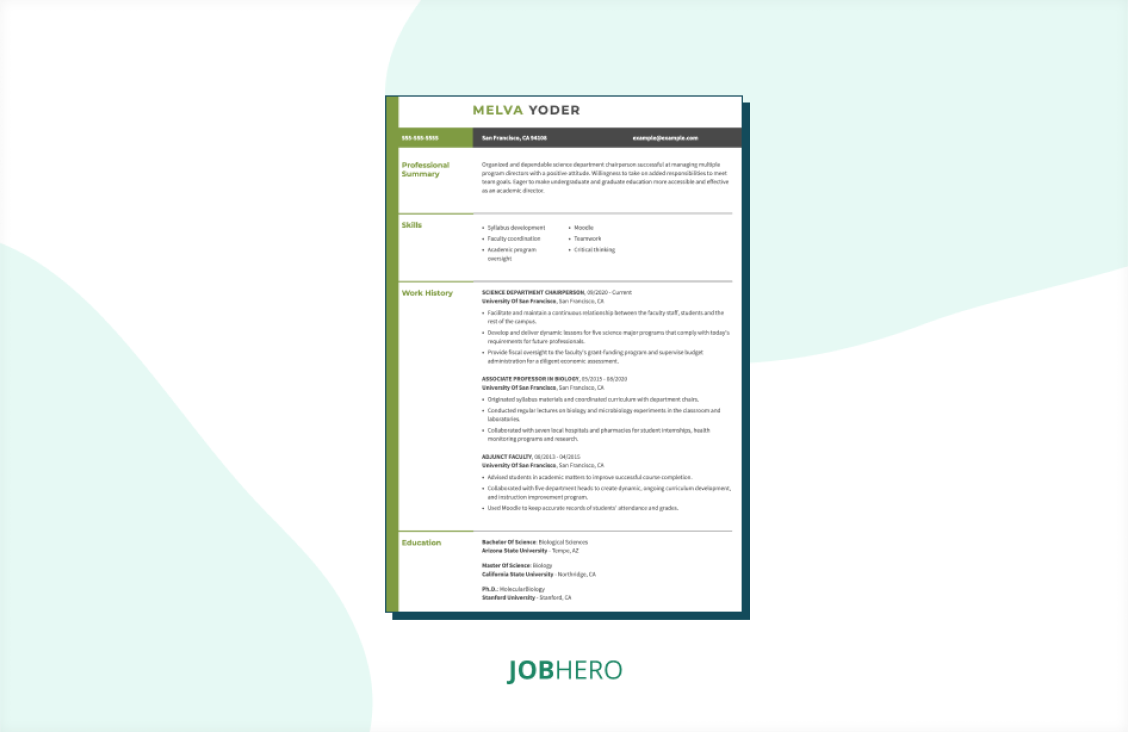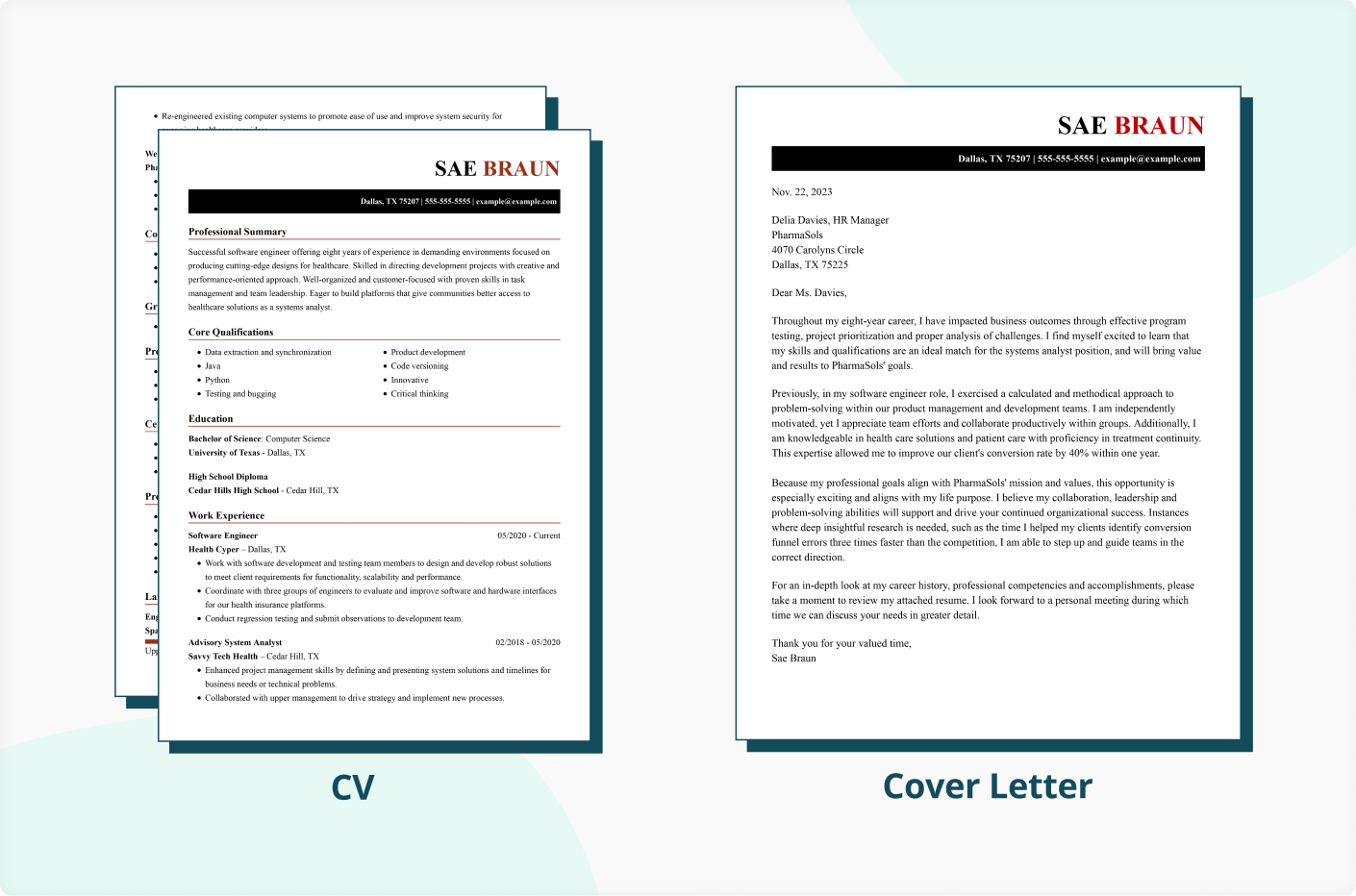- Featured in:
CV Writing Guide
Here are the 11 primary sections to include in your CV:
- Contact Information
- CV Summary or Objective
- Academic history (in reverse-chronological order)
- Research interests (or area of focus or expertise)
- Publications
- Presentations
- Professional experience
- Scholarships, honors and awards
- Languages
- Licenses, certificates, special skills and achievements
- Professional memberships or affiliations.
Wondering how to create a CV? Save time and hassle by using our CV Builder. Designed with AI-powered tools to auto-suggest phrases and keywords relevant to the industry that you are applying.
These sections can be listed differently, depending on which areas you want to highlight. With this in mind, here’s some essential guidance on how to write a good CV, section by section.
Mandatory sections include:
1 Contact information
Like your resume, your CV will begin with your name and contact information. Start with your full name in a more extensive and bold font. Then add your current contact information, including your email and phone number.

2 CV Summary or Objective
Make a defining statement that tells employers your expertise and career goals. Keep your sentence concise and relevant by customizing this section to match the job description.

3 Licenses, certificates, special skills and achievements
List all your relevant licenses, certificates and achievements. Ensure you include the license or certificate name, the date you earned it, and the institution that awarded it.

4 Professional experience
Outline your employment history with a section that lists the names of all the organizations or companies where you’ve worked, your job titles, the dates of your employment and a summary of your skills and achievements. Include both hard and soft skills here. You can break these out with bullet points.
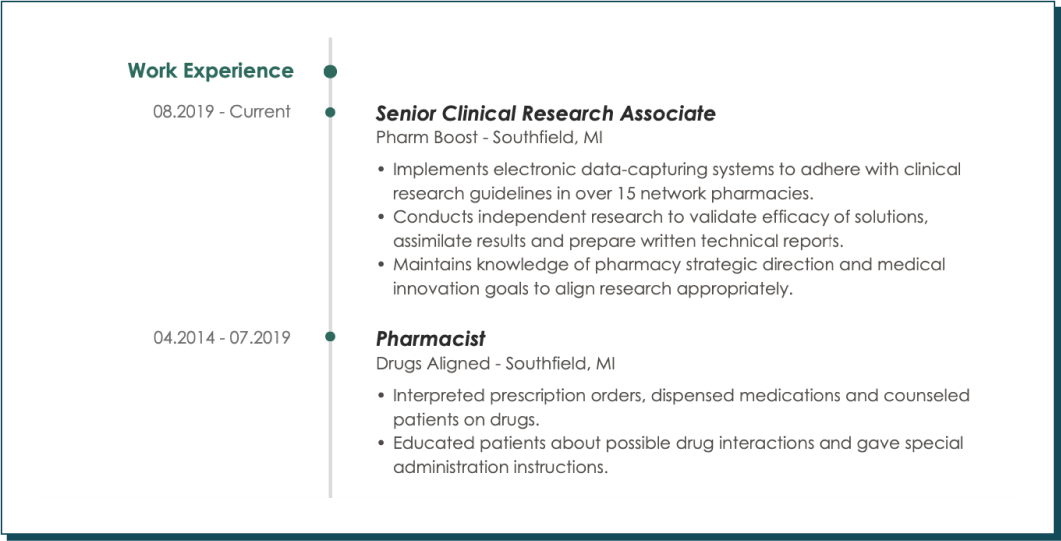
5 Outline your academic history.
Typically, the first heading of a CV is your education rather than your most recent work experience. Under this heading, include the name of the school, the year you graduated, and details such as the title of your dissertation or thesis. Your CV should list your education in reverse-chronological order. So after a Ph.D., list other postgraduate degrees, such as a master’s degree, and then your undergraduate education. You don’t need to include anything earlier than your college education.

Optional CV sections include:
6 Describe your research interests.
For example, if you are an academic researcher, the first significant heading of your curriculum vitae might be “Research Interests,” and beneath that heading, you would list your focus areas.

7 List all your relevant publications.
If you are a published author, you can include a section listing any publications, including books and peer-reviewed journals. Include a full citation, including the names of any co-authors, the date each publication first appeared and a summary.

8 Describe any presentations you’ve given.
If you have delivered lectures, organized conferences or given presentations, consider adding a section heading. Be sure to provide the title, date and venue where you gave each presentation and a summary of the subject matter.

9 List your scholarships, honors and awards.
Use this section to detail any honors, grants, fellowships, scholarships or awards you earned. Remember to include the name of each grant or scholarship, the name of the institution that provided it and the date you received it.

10 List any languages in which you have fluency.
If it’s directly relevant to your career path, you might include a section listing the languages you are fluent in. However, if you are applying for a position as a molecular biologist, it’s not necessary to mention that you can speak Yiddish. The guiding principle is always to consider whether the information is relevant to a job application.

11 Note your professional memberships and affiliations.
End with a section detailing all of your relevant professional memberships and affiliations. List each organization’s name and location and the dates of your active membership.

How do you write a good CV for a job and make it stand out? The most effective way is to adapt it to the applicant tracking system (ATS). Employers use this software to scan and rank CVs and job applications. It’s designed to look for keywords and phrases related to the job description. For this reason, make sure to identify these keywords and use them throughout the sections of your CV.
Another great way to stand out from the pile of competing candidates is by making your CV visually appealing. Set the tone with our unique layouts, professional designs and downloadable CV templates for an aesthetic appeal.
CV Versus Resume:
When to Use a CV?
Curriculum Vitae
Length: The main difference between a curriculum vitae and a resume is the number of pages you submit. A CV can be around two to three pages or longer because it presents a complete history of your academic credentials and profound insight into your work experience.
Content: A CV covers all aspects of your education, work and experience without the length restriction. A CV will dive deeper into your professional and academic achievements, listing scholarships, awards, conferences and publications.
Resumes
Length: A resume concisely outlines your skills and qualifications. The length of a resume is one to two pages. The information is concise and limited to critical facts about your credentials that the hiring manager should know.
Content: Your resume must be tailored to match each job you apply for. In other words, you will likely have to continue creating multiple versions of your resume tailored for different jobs.
When to use a CV?
International jobs require a CV. If you’re looking for a job overseas, including in Asia, Africa and Europe, you may be asked to submit a curriculum vitae rather than a resume.
A curriculum vitae is most commonly required in the United States when applying for federal jobs, academic positions, and science and research. You may also be asked to submit a CV if you apply for a fellowship or grant.
Here are a few of the jobs that may require a CV:
- Scientists
- Academic researchers
- Art curator
- Teachers
- Professors
- Clinicians
- Federal jobs
Do’s and Don’t’s to Make Your CV Stand Out
- Take the opportunity to start your CV strong. Use your summary, skills and key accomplishments to attract the recruiter’s attention.
- Do focus on the visual appearance of your CV. It should be both visually appealing and easy to read.
- Include career gaps in your CV. Simply use your cover letter to explain your reasons to avoid red flags. By doing so, you show honesty and positivity, rather than avoidance.
- Keep your CV as concise as possible. Generally, if you are applying for junior roles, a CV should be at most two pages, while senior roles or a more experienced candidate could go onto three sides. Federal jobs may require additional pages to show deployments and specific criteria.
- Always proofread your CV to avoid grammatical errors. CVs are long and can cause you to overlook spelling errors and typos. Have a second pair of eyes read your CV, not only for typos and spelling but also for general readability.
- Avoid being outdated. Only use information that is relevant to the job.
- Don’t include age, ethnic identity, political affiliation, religious preference, hobbies, marital status, sexual orientation, place of birth, photographs, height, weight and health.
- Don’t be too brief, but keep the information concise. Avoid light summaries; instead, use the opportunity to create compelling descriptions of your skills and accomplishments.
- Do not include references or write “References available upon request.”
- Never lie or exaggerate information on your CV.
CV Tips to Get Noticed by Recruiters
The average time hiring managers or recruiters spend reviewing a CV is six-to-eight seconds. Additionally, recruitment agencies usually rely on ATS and AI screening tools to scan for candidates. Considering this, let’s review how to write a CV for a job application and the five best tips to get recruiters to notice your CV in 2023.
Add a Cover Letter
A cover letter is critical to your job-search strategy. It becomes a significant opportunity to impress employers even before they meet you!
Harvard Business Review underlines the importance of pairing your CV or resumes with a cover letter as the best chance to distinguish yourself in front of recruiters. A well-written cover letter allows you to be noticed and considered a strong candidate amongst tough competition.
Here are the top three reasons why a cover letter will help set you apart:
1 Puts a spotlight on your qualifications.
A cover letter is a critical way to show how your skills and experience meet the key requirements the employer is looking for. It is your chance to demonstrate that you have the knowledge, experience and abilities needed for this new role.
2 Gives a glimpse of your unique personality.
Set the tone with insights into your personality. Choose terminology and wording that can give recruiters a glimpse of your expertise and willingness for the job. Define your career goals and explain in your own words why you are the best person for the job.
3 Go the extra mile.
The meaning behind a cover letter is that it demonstrates that you took the time to research the hiring manager’s name and put thought and effort into your application.
JobHero also features a Cover Letter Builder to make your application process more manageable. This online tool walks you through each part of your letter, auto-suggesting keywords and phrases to create an industry-specific letter.
PRO TIP:
When you format your CV, use the same font and matching or similar template you chose for your resume and cover letter to create a seamless and consistent look across every element used in your job search.
CV FAQ
How do you write a CV for the first time?
Here is a step-by-step guide to how to write your first CV:
1. Choose the best format.
- Chronological: Lays your experience in a reverse timeline or chronological order to show a career progression.
- Functional or skills-based: Ideal for students, candidates switching careers or having time gaps. This type of format highlights your skills instead of your experience.
- Combination: A combination resume is also known as a hybrid resume because it combines the best of a chronological and functional format. This mix starts with details of your work accomplishments while prominently showcasing your relevant skills. A combination resume is an excellent option for mid-level candidates or people changing careers.
2. Organize your CV sections.
Define your sections with bold headers that can outline the parts of your CV for an easy-to-read and clean document.
- Header (including your name, address and contact details)
- Summary statement
- Skills
- Experience
- Education
- Awards and certifications
- Portfolio (if applicable)
3. Develop your content.
Avoid feeling overwhelmed. Simply focus on one section at a time. Use each part of your CV to shed insight into your skills, areas of study and academic achievements and provide valuable context about your background.
When writing about your accomplishments or duties, use numbers to add credibility to your CV. This also becomes a way to draw the recruiter’s attention.
What is the best CV format?
The most common format highly favored by recruiters is the reverse-chronological format. It is preferred by recruiters and ATS software because it is simpler to read.
This format highlights your work experience, with the most recent or current jobs listed at the top of your experience section. This way, the recruiter will see your most recent experiences first. This type of format is favored because it is an excellent way of showing your career progress and is ideal if you’re looking for a job in the same field as you’re currently in.
Is a CV the same as a resume?
CV is an abbreviation of Curriculum Vitae, which translates to “the course of your life.”
A CV has a different focus than a resume. CVs describe your career journey step-by-step, including all the research, volunteer and academic work.
It is a comprehensive description of all your achievements, portfolios or publications. It is a professional opportunity to showcase your career progress, certificates and awards. Resumes differ from CVs in length because they range between one to two pages. While the length of a CV depends on the amount of experience, it can vary from two to eight pages.
What makes a good CV?
A good CV shares these qualities:
- Defines skills that align with the job requirements.
- Demonstrates you understand the company’s objectives and can contribute to their success.
- Shows that you have tailored your CV to what the employer is looking for in a candidate.
- Your CV is easy to read and understand.
- The credentials and information you’ve presented are genuine and honest.
How do I write my first CV with no experience?
If you are a freelancer, just starting this career or just graduated, the best way to write a CV is to choose a functional format.
This is a skills-based CV that focuses on the candidate’s skills instead of work history. This is a quick overview of how you would organize your CV with a functional format:
- Contact information
- CV objective
- Skills summary
- Volunteer or work experience
- Education
- Additional skills




